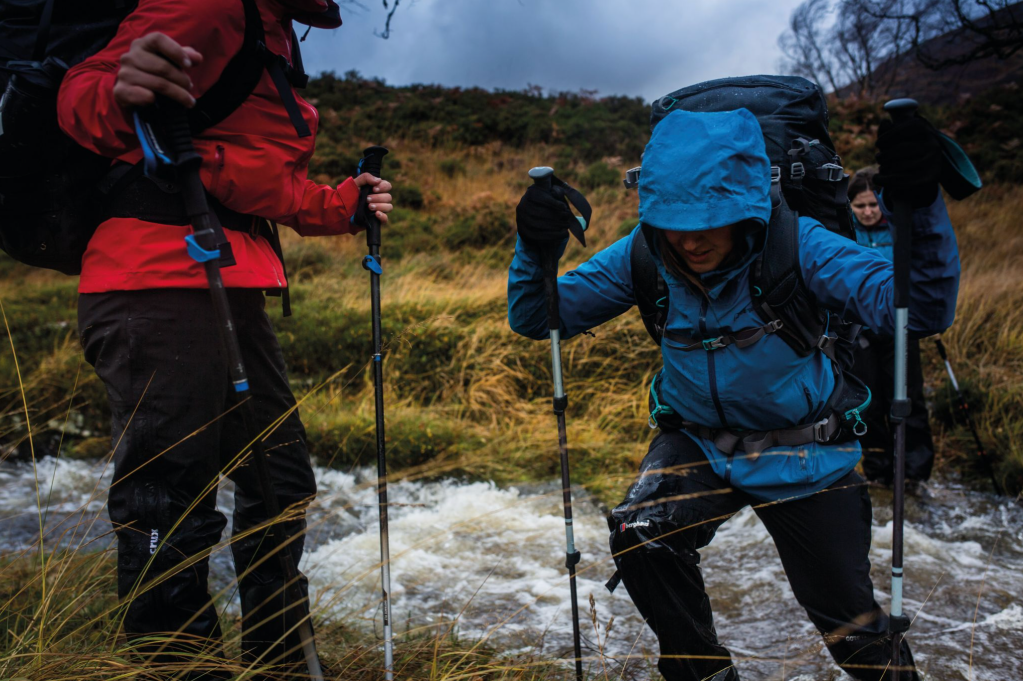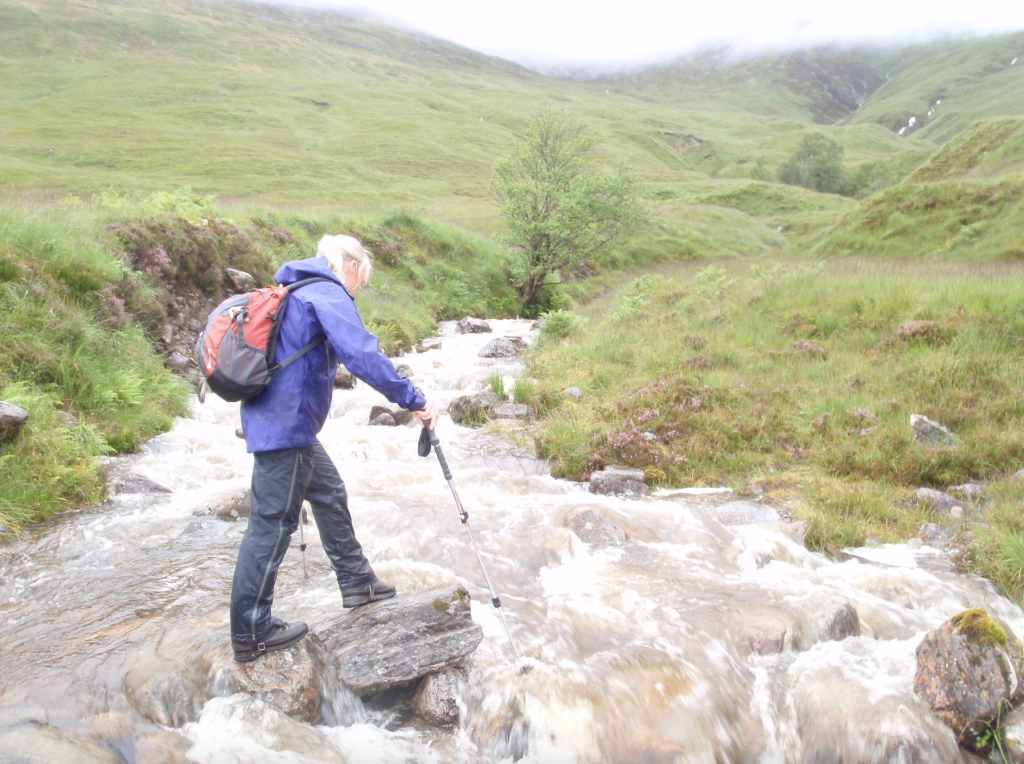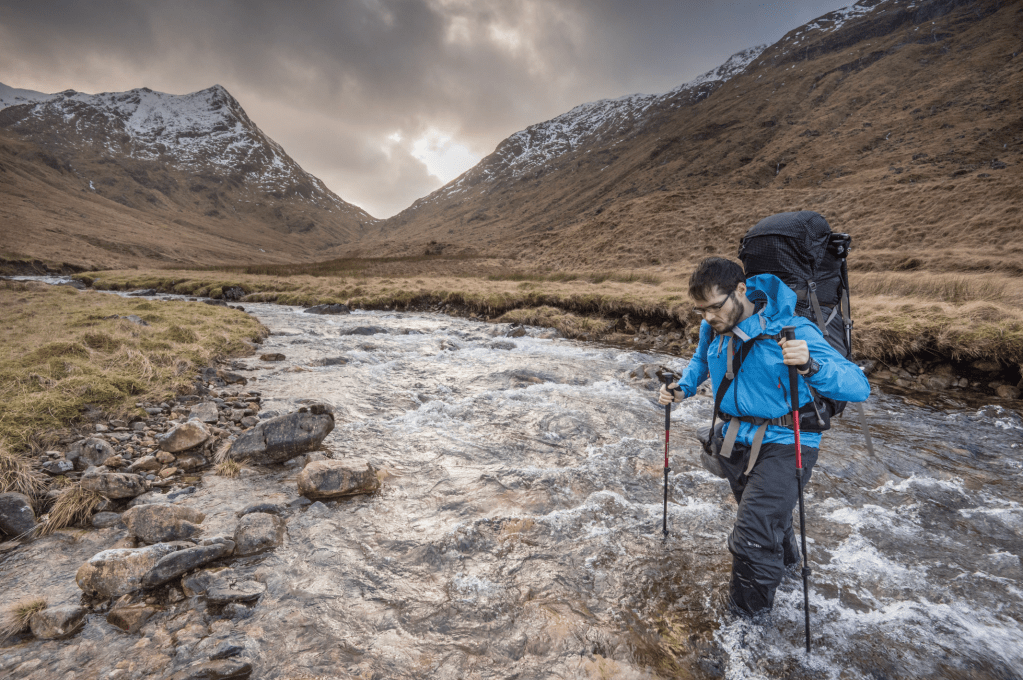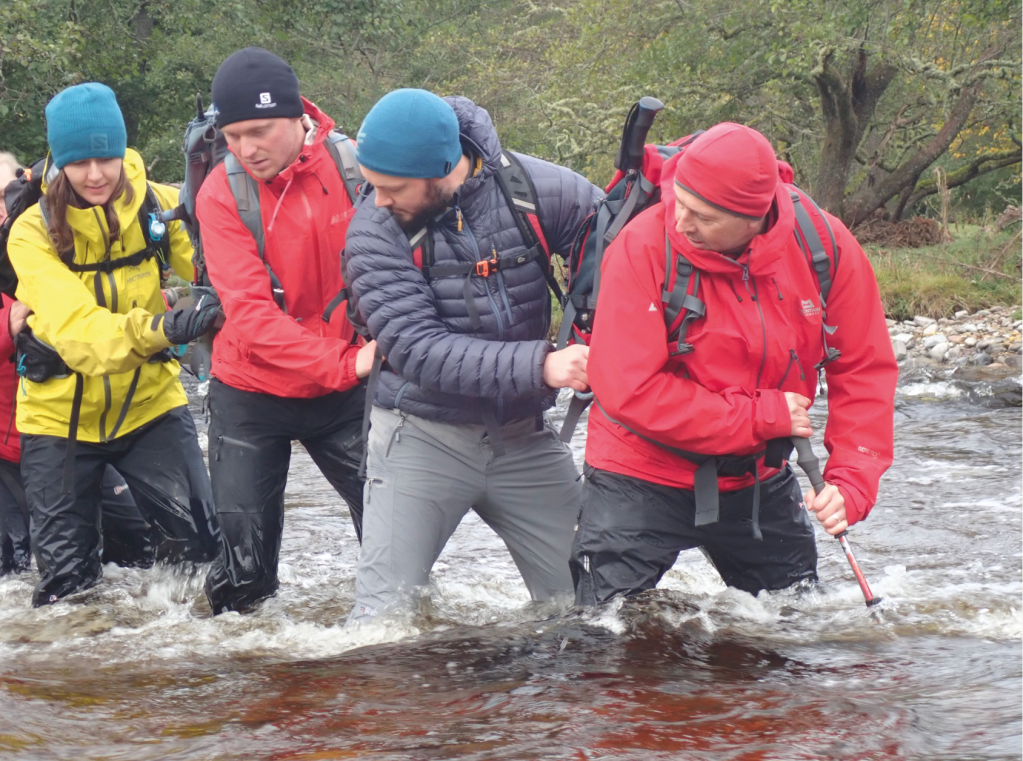During the summer months, walkers may hunt out serene waterside rambles through glens and up mountain streams. But our waters are powerful, and these walks are not without their own hazards. Here, Glenmore Lodge Chief Instructor Heather Morning guides us across the rivers and streams of our high places – and explains how to stay safe.
Many (if not all!) readers of The Great Outdoors magazine will be only too familiar with our challenging mountain weather. Wind, rain, sleet, snow, sunshine, showers, downpours – and that’s all in one day sometimes. The UK is an island nation located at the eastern extremity of the Atlantic and, therefore, it is the first stop for many low-pressure systems and their associated frontal systems bringing precipitation. This is particularly relevant for the mountains located on the western side of the UK where the air masses are lifted as they move over the mountain ranges, producing precipitation known as orographic rainfall.
This article is sponsored by our friends at Glenmore Lodge.
Main image: A river crossing below An Teallach | Credit: James Roddie
So, what does this mean for us as hillwalkers? Following periods of high rainfall, river, stream and burn crossing which might normally be very manageable may be transformed into raging, uncrossable torrents of water leaving us stranded and a long way from our transport or-given historical incidents of drowning in the mountains-much worse.
Remember, any water that is over knee-deep is likely to be alarmingly powerful and difficult to manage even for the fittest hillwalker. But, fear not, as by planning ahead it’s easy to avoid getting into difficulties. Here are a few ‘top tips’ to consider before you get beyond your front door.
SUMMER SHOWERS
Always research the mountain weather forecasts prior to your adventure. The Mountain Weather Information Service and Met Office Mountain Forecasts are my ‘go to’ pages for detailed mountain weather information. But don’t simply seek out information for your adventure day of choice itself. Make sure you look at the preceding daily weather forecasts, too.
The rain might have stopped; but if there has been heavy rain for the days running up to your walk, the rivers will still be affected. It takes several hours for the water to run off and the levels subside.

Iona Andean on a river crossing. Credit: Jessie Leong
WET, WET, WET
So, boots or no boots? There are pros and cons here. The river or stream bed is likely to be rocky and difficult to manage in bare feet. Your boots should provide stability and grip should you stumble upon a slippery surface. Whilst getting your boots totally soaked on a multi-day trip brings its own challenges, boots are advised.
AVOIDANCE IS KEY
Always make water crossings a consideration when planning your route following a period of wet weather. Look closely at your intended route and identify any potential problems well in advance. This may involve a detour to a bridge or, in remoter areas, taking a route that crosses valleys or glens at the watershed (or high point) away from danger.
Of course, your final option is to wait until the water level reduces to cross. This could take several hours and likely you could be very wet, so hypothermia then becomes a real risk. If the forecast is foreboding and you are not confident in river crossings after heavy rain, simply wait to do your walk another day.
The mountains will still be there and, when it comes to crossing rivers, avoidance is key. Sometimes, however, avoidance is impossible. In the case you do have to go forth with a river crossing, the following advice must be followed to ensure your safety.

A river crossing in the western Highlands. Credit: Glenmore Lodge
WHERE TO CROSS
Choose your crossing place with care, even if that means spending time walking up and down the river to search for the safest crossing point. Considerations should The Line Astern method in action include access points, width of river, water speed, composition of the stream bed and what lies downstream.
Access
Choosing a bend in the river may not be wise as you may not get a clear view of the downstream hazards. More importantly, you should avoid bends where accelerated flow of water on the outside of the bend can erode and undercut the bank, unbeknownst to you at an eye line way above the water level.
Find a shallow access point to step down into instead and check the other side for case of egress. Look for braiding where the river divides into many shallow channels with small islands. However, note well that ‘boulder hopping’ may not be your best choice as the boulders may well be slimy and cause slips.

Alex Roddie tackling a Cape Wrath river crossing. Credit: James Roddie
Width
Look upstream to where the stream may be split into smaller tributaries. Your map may help identify this. Rivers and streams are marked on Ordnance Survey maps as blue lines. A double blue line with light blue in between indicates a river width of more than 8m. If the marking is a single blue line, you can expect a crossing of less than 8m. However, the safest option may be to choose a shallower, wider section and commit to getting wet feet.
Stream bed
Are there places where the river or stream bed looks less rocky? It is far better to choose a wider and sandy section on which you can avoid the hazard of slipping or foot entrapment on a rocky riverbed. With absolute confidence in the crossing-clear, slow-moving water revealing a flat, sandy stream bed with no irregularities-you may even choose to remove your boots to keep them dry. It’s worth noting, though, that most mountain streams or bums would not fit this description and it’s recommended you wear boots for protection and stability.
Downstream hazards
What lies just downstream? You must ask yourself this question and examine the water for hazards – waterfalls, boulders, fallen trees, deep pools – in case you do slip. It ought to go without saying, but crossing directly above a significant drop is not your wisest choice. Stay well away from crossing above overhanging trees or tree debris in the water. These are known as ‘strainers’ and can lead to entrapment if you lose your footing.
HOW TO EXECUTE A SUCCESSFUL RIVER CROSSING
If you’re alone, you must not attempt a river crossing without one or two walking poles. These can be used for stability as you cross, creating an extra point of contact with the river bed. Move just one point at a time, maintaining a foot-foot-pole’ movement sequence. Face upstream and move diagonally across the river or stream.

The Line Astern method. Credit: Heather Morning
The ‘line astern’ method
In a group, a river crossing can be more secure if using the recommended method. Indeed, using the stability of other people is essential if the river or stream crossing is not straightforward. The most practical way of doing this is the ‘line astern’ method, in which the key is to try to present as small a surface area to the current as possible. In this method, the group lines up behind the strongest person.
The leading person is supported by the people behind, who should push downwards on the hips of the person in front of them. The person in front should be facing up stream into the current and use poles for stability. This crossing method works well if there are some smaller people with you who will benefit from the ‘eddy’ created by the larger person at the front.
Clearly the decision to cross a river or stream when it’s not obviously straightforward and inconsequential is very serious. If in doubt do not cross. Pre-planning and research before you adventure beyond your front door should mean that you stay well clear of getting into difficulties – and get to keep your feet dry!
Glenmore Lodge is sportscotland’s National Outdoor Training Centre. Based near Aviemore in the Cairngorms National Park and founded in 1948, it exists to support individuals to access the outdoors safely and responsibly through providing skills training and inspiring adventure. Whether it’s trying a new way to enjoy the outdoors, aguided adventure, or professional experienced Instructors are ready to support everyone to develop their skills and achieve their aspirations in the outdoors.
Learn more at glenmorelodge.org.uk.







